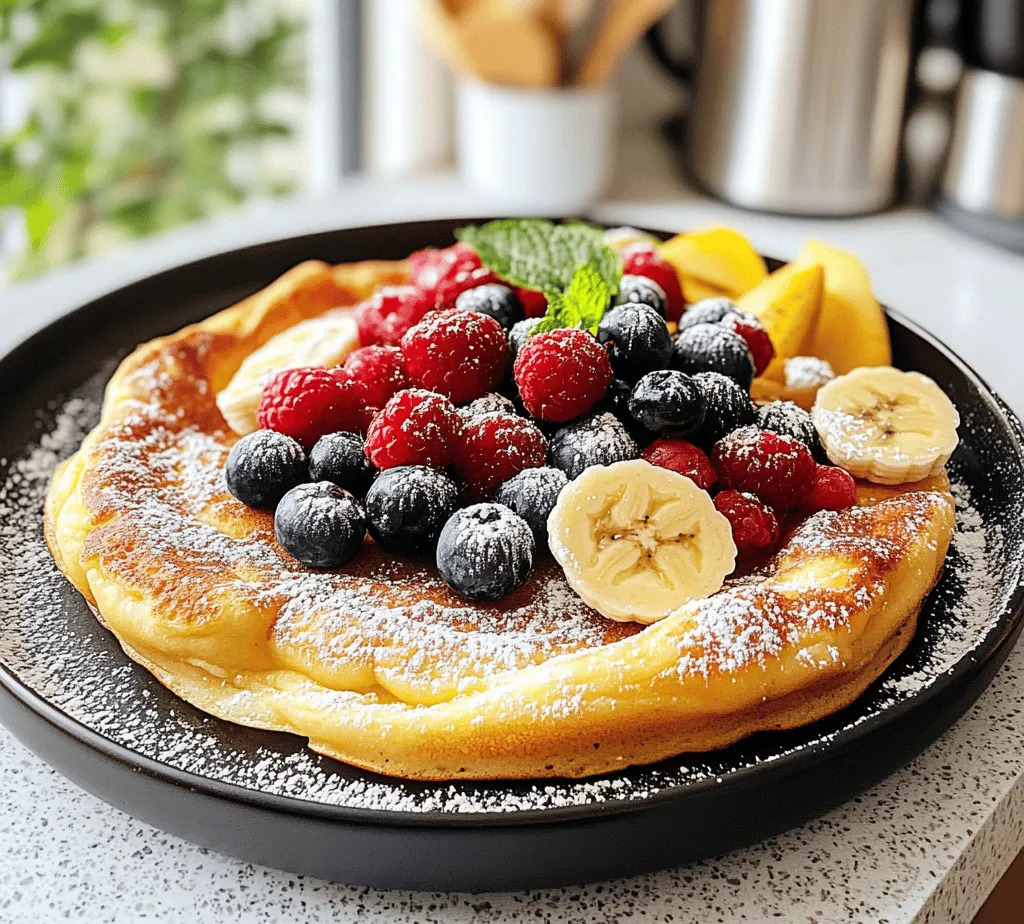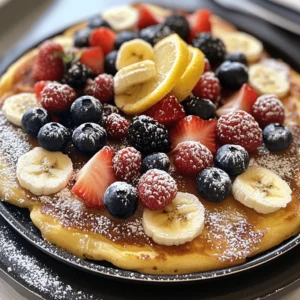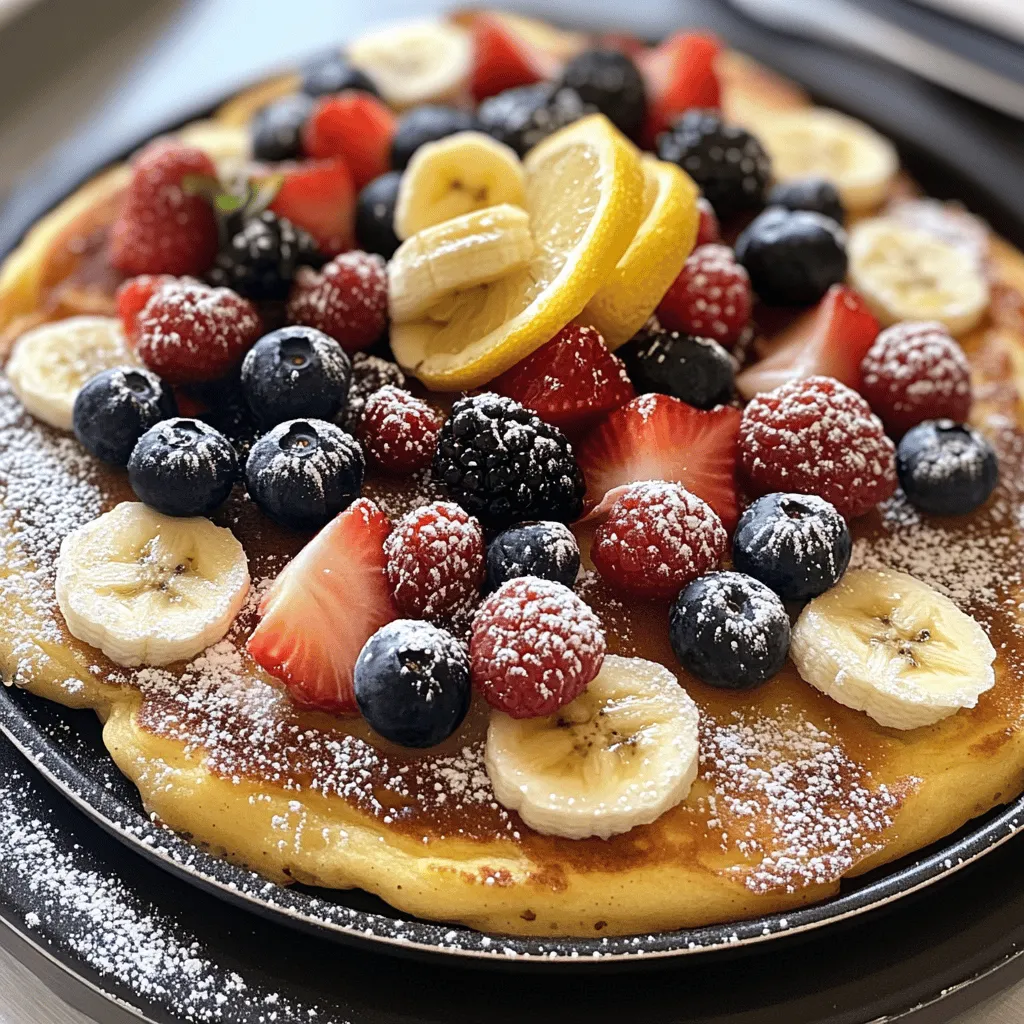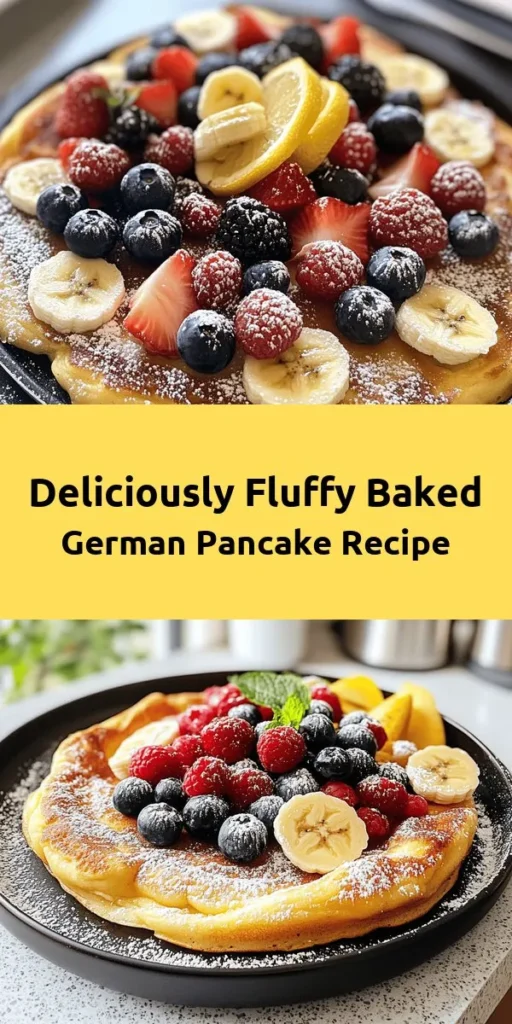Introduction
If you’re looking to elevate your breakfast game, a Fluffy Baked German Pancake may just be the dish you need. Unlike traditional pancakes that are cooked one by one on a griddle, the German pancake, also known as a Dutch baby, is baked in the oven. This unique cooking method results in a light, airy texture that rises beautifully, creating a stunning centerpiece for any breakfast table. Families and friends gather around this delightful dish, savoring its delicate flavor and impressive appearance.
The baked German pancake is gaining popularity not only for its delightful taste but also for its simplicity. With just a handful of ingredients and minimal preparation time, you can whip up a delicious breakfast or brunch that will impress everyone. Whether you’re hosting a weekend brunch or enjoying a quiet family breakfast, this pancake is sure to be a hit.
Understanding the Fluffy Baked German Pancake
The Fluffy Baked German Pancake is a culinary marvel. Imagine a pancake that puffs up dramatically in the oven, creating a golden-brown exterior that is crisp, while the inside remains soft and custardy. Its flavor profile is subtly sweet, allowing for a variety of toppings that can enhance the experience. With every bite, you’ll taste the richness of the eggs and the creaminess of the milk, balanced perfectly with just a hint of sweetness.
Historically, the German pancake has its roots in the early 19th century, originating in Germany and gaining popularity in the United States in the 1900s. This dish has evolved from a hearty breakfast option to a beloved brunch favorite, often found in cafes and homes alike. Its effortless preparation and the wow factor when served have made it a staple in many households.
Baked pancakes, like the Fluffy Baked German Pancake, have become a popular choice among home cooks for several reasons. First, they eliminate the hassle of flipping individual pancakes, allowing you to create a beautiful dish that serves multiple people at once. Additionally, the baking process allows for a unique texture that is hard to replicate on a stovetop. As the batter bakes, it rises to create a magnificent puff, leaving you with a dish that looks as good as it tastes.
Key Ingredients for Success
To create the perfect Fluffy Baked German Pancake, you’ll need a few essential ingredients. Each plays a crucial role in achieving the desired texture and flavor.
All-Purpose Flour
All-purpose flour is the backbone of any pancake recipe. It provides the necessary structure and contributes to the fluffiness of the pancake. When combined with the liquid ingredients, it helps create a batter that rises beautifully in the oven, resulting in that signature puffed-up appearance.
Milk
Whole milk is the preferred choice for this recipe as it adds creaminess and richness to the pancake. The fat content in whole milk enhances the flavor and texture, making the pancake even more delectable. If you prefer a lighter version, you can substitute with low-fat milk, but keep in mind that the overall richness may be reduced.
Eggs
Eggs are the star ingredient in a baked German pancake. They act as a binding agent, holding the ingredients together while also contributing to the pancake’s fluffiness. As the eggs cook, they create a light and airy texture that is characteristic of this dish. The more eggs used, the fluffier the pancake becomes.
Unsalted Butter
Unsalted butter not only adds flavor but also provides moisture to the pancake. Melting the butter in the baking dish before adding the batter creates a delightful crispy edge, enhancing both taste and texture. It’s important to use unsalted butter so you can control the amount of salt in the recipe.
Granulated Sugar
A touch of granulated sugar balances the flavors in the pancake, adding just the right amount of sweetness without overpowering the other ingredients. It also aids in browning the pancake as it bakes, giving it that golden finish.
Vanilla Extract
Vanilla extract adds depth of flavor to the pancake, elevating it from a simple breakfast to a delightful treat. The warm, aromatic notes of vanilla complement the eggs and sugar, rounding out the dish beautifully.
Salt
While it may seem like a small amount, salt plays a crucial role in enhancing the overall taste of the pancake. It helps to bring out the sweetness and balances the flavors, ensuring that each bite is delicious.
Optional Toppings
One of the best parts of the Fluffy Baked German Pancake is the array of toppings you can choose from. Here are some popular options:
– Fresh Fruits: Berries, bananas, and apples not only add nutritional benefits but also provide a pop of color and flavor. They can be served fresh or sautéed in a bit of butter and sugar for a warm topping.
– Powdered Sugar: A classic way to serve this pancake is with a dusting of powdered sugar. It adds a touch of sweetness and makes for an appealing presentation.
– Maple Syrup: Drizzling warm maple syrup over the pancake enhances the sweetness and adds a rich flavor that pairs perfectly with the fluffy texture.
– Whipped Cream: For a decadent treat, top your pancake with a dollop of whipped cream. This adds a creamy element that complements the pancake’s lightness.
Step-by-Step Instructions for Baked German Pancake
Now that you understand the ingredients and their significance, let’s dive into the preparation process. Making a Fluffy Baked German Pancake is straightforward and can be completed in just a few simple steps.
Preheat the Oven
Start by preheating your oven to 425°F (220°C). This high temperature is essential for achieving the pancake’s puffiness, as it cooks quickly and evenly.
Prepare the Baking Dish
While the oven is preheating, take a 9×13-inch baking dish and add a generous amount of unsalted butter. Place the dish in the oven for a few minutes until the butter is melted and bubbling. This creates a flavorful, crispy edge for the pancake.
Mix the Batter
In a mixing bowl, combine the eggs, whole milk, granulated sugar, vanilla extract, and salt. Whisk these ingredients together until well blended. Next, gradually add the all-purpose flour, mixing until just combined. Be careful not to overmix, as this can lead to a denser pancake.
Pour and Bake
Once the butter in the baking dish is melted, carefully remove it from the oven. Pour the batter directly into the hot dish, allowing the melted butter to coat the bottom. This step is crucial for creating that wonderful texture and flavor.
Immediately return the dish to the oven and bake for 20-25 minutes or until the pancake is puffed up and golden brown. Avoid opening the oven door during baking, as this can cause the pancake to deflate.
The anticipation builds as you wait for your pancake to rise and turn a beautiful golden brown. Once baked, you’ll be greeted with a stunning fluffy creation that is ready to be topped and served.
—
Stay tuned for the next part of this article, where we’ll explore tips for achieving the best results and answer common questions about making a Fluffy Baked German Pancake!

Mixing the Batter: Tips for Achieving a Smooth Consistency
The key to a perfect fluffy baked German pancake lies in the batter, which should be smooth and well-blended. Start by whisking together the eggs, milk, and flour in a large mixing bowl. It’s important to combine the wet ingredients first, ensuring that the eggs are fully beaten before adding the flour. This helps to prevent lumps and ensures an even texture. A hand whisk or an electric mixer can be used for this step, but take care not to overmix. Overmixing can incorporate too much air into the batter, which may cause the pancake to deflate during baking.
When adding the flour, sift it if possible. Sifting helps to aerate the flour and removes any clumps, leading to a smoother batter. If you find that lumps persist, use a spatula to gently fold the batter until smooth. The consistency should be similar to that of a thin pancake batter. If you desire a richer flavor, add a pinch of salt and a splash of vanilla extract to enhance the overall taste.
Importance of the Hot Baking Dish for the Perfect Rise
One of the secrets to achieving that coveted puffiness in your German pancake is the use of a preheated baking dish. This step is crucial as it creates an immediate reaction when the batter hits the hot surface, leading to rapid steam production. The steam expands and lifts the batter, resulting in a beautifully risen pancake.
To prepare your baking dish, you can use a cast-iron skillet or a glass baking dish. Regardless of your choice, ensure that it is generously greased with butter or oil before placing it in the oven to preheat. This not only prevents sticking but also contributes to a crispy outer edge. Preheat your oven to 425°F (220°C) and place the baking dish inside while the oven heats up. It’s essential to wait until the oven reaches the desired temperature before adding the batter.
Baking Time and Visual Cues for Doneness
Once your batter is thoroughly mixed and your baking dish is hot, it’s time to bake your pancake. Carefully remove the hot dish from the oven and pour the batter into it. You will hear a satisfying sizzle as the batter meets the hot surface. Return the dish to the oven immediately to maintain the temperature.
Bake the pancake for about 20-25 minutes, but keep an eye on it as baking times can vary based on your oven. The pancake is done when it has puffed up with golden-brown edges and a slightly wobbly center. If you gently shake the pan, the center should jiggle slightly but not appear liquid. For a more accurate assessment, you can insert a toothpick into the center; it should come out clean or with just a few moist crumbs.
Explanation of the Cooling Process and Its Effects on the Pancake’s Structure
After removing the pancake from the oven, allow it to cool for a few minutes before serving. During this time, the pancake will begin to deflate slightly, which is completely normal. This cooling process helps set the structure of the pancake, ensuring it retains some of its height without collapsing completely.
If you serve the pancake immediately, expect it to be puffy and airy. As it cools, it will settle, making it easier to slice and serve. The texture should remain tender and fluffy, with a delightful contrast between the edges and the center.
Serving Suggestions and Variations
Traditional Serving Methods with Powdered Sugar and Fruit
This fluffy baked German pancake is incredibly versatile and can be served in a variety of ways. The classic method involves dusting the pancake with powdered sugar and serving it with fresh fruit such as berries, sliced bananas, or citrus segments. The sweetness of the powdered sugar complements the natural sugars in the fruit, creating a delightful breakfast or brunch dish.
For an extra touch, consider drizzling warm maple syrup or honey over the top. The combination of flavors makes for a satisfying and visually appealing presentation.
Creative Variations for Different Flavors and Dietary Preferences
If you want to mix things up, there are countless variations to explore. For those who enjoy a bit of spice, consider adding cinnamon or nutmeg to the batter. These spices enrich the flavor profile and make the pancake feel extra cozy, perfect for chilly mornings.
You can also incorporate chocolate chips or nuts for added texture. Simply fold them into the batter just before pouring it into the hot dish. Dark chocolate chips bring a rich sweetness, while nuts add crunch and nutritional benefits. If you have dietary restrictions, feel free to experiment with alternative milk—such as almond, coconut, or oat milk—and swap regular flour for gluten-free flour.
Suggestions for Using Alternative Milk or Gluten-Free Flour
When using alternative milk, ensure it is unsweetened to maintain the balance of flavors. Gluten-free flour blends can work well in this recipe, but keep in mind that different blends may yield varying results. A blend that contains xanthan gum is often recommended for better structure.
Nutritional Information
Understanding the nutritional benefits of your ingredients can help you appreciate this delightful dish even more. A typical serving of a fluffy baked German pancake made with eggs, milk, and flour contains a good balance of macronutrients: protein from the eggs and milk, carbohydrates from the flour, and some healthy fats from the butter used in greasing the baking dish.
Overview of the Nutritional Benefits of the Ingredients Used
– Eggs: A great source of protein and essential vitamins, including B12 and riboflavin.
– Milk: Provides calcium and vitamin D, which are crucial for bone health.
– Flour: A source of carbohydrates for energy; whole wheat flour can be used for added fiber.
– Butter: Adds flavor and healthy fats, and can be substituted with alternatives like coconut oil or vegan butter for a dairy-free version.
Breakdown of Calories, Macronutrients, and Vitamins
A serving of a fluffy baked German pancake typically contains around 200-300 calories, depending on the specific ingredients and how it’s served. Here’s a general breakdown you might expect per serving:
– Calories: 250
– Protein: 8g
– Carbohydrates: 30g
– Fat: 10g
– Fiber: 1g
This pancake can fit into a balanced diet and can be enjoyed as part of a hearty breakfast or a light dessert when paired with fruit.
Common Mistakes to Avoid
While making a fluffy baked German pancake is relatively straightforward, there are common pitfalls to avoid to ensure perfect results.
Discussion of Frequent Errors Made While Preparing German Pancakes
1. Overmixing the Batter: As mentioned earlier, overmixing can introduce too much air, causing the pancake to deflate. Mix just until combined.
2. Not Preheating the Baking Dish: Failing to preheat the dish can result in a flat pancake. Always ensure your dish is hot when the batter is poured in.
3. Opening the Oven Door Too Soon: This is a critical mistake as it can cause sudden temperature drops, leading to a deflated pancake. Avoid peeking until the minimum baking time has passed.
4. Not Using Enough Fat: Insufficient greasing can lead to sticking. Make sure your baking dish is generously coated with butter or oil.
Tips for Troubleshooting Issues Like Deflation or Uneven Cooking
If your pancake deflates, it may be due to overmixing or removing it from the oven too early. For uneven cooking, ensure that your oven is properly calibrated and consider rotating the dish halfway through baking for even heat distribution.
Conclusion
In summary, the fluffy baked German pancake is a delightful and simple dish that can impress anyone at the breakfast table. Its charm lies in its ease of preparation and the endless possibilities for customization, making it a versatile choice for various occasions, from casual family breakfasts to festive brunch gatherings.
With its irresistible puffiness, delicious flavor, and adaptability to different dietary needs, this pancake is bound to become a favorite in your kitchen. We encourage you to try this recipe and share your experiences, whether you stick to the classic version or get creative with your own variations. Happy cooking!



